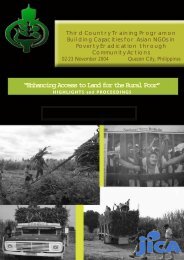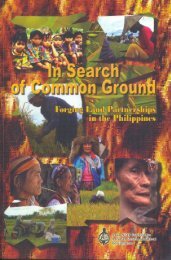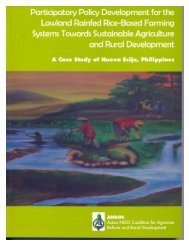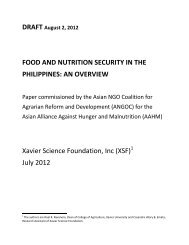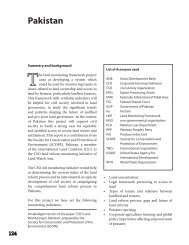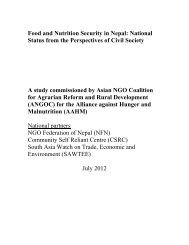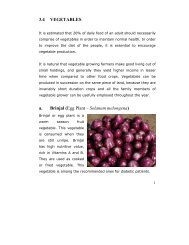Traditional Practices in Agriculture FULL - ANGOC Site
Traditional Practices in Agriculture FULL - ANGOC Site
Traditional Practices in Agriculture FULL - ANGOC Site
Create successful ePaper yourself
Turn your PDF publications into a flip-book with our unique Google optimized e-Paper software.
The oil cake conta<strong>in</strong>s 7-8% of N, 1.5% of P 2 O 5 and 1.2% of K 2 O<br />
and is used both as a manure and as a cattle feed. The haulms<br />
after dry<strong>in</strong>g or silage are fed to cattle. Groundnut shell can be used<br />
as a fuel and mulch<strong>in</strong>g purpose for the plants. It is termed as a<br />
pseudo-legume with root nodules and thus is capable of<br />
synthesiz<strong>in</strong>g atmospheric nitrogen and thereby improve the soil<br />
fertility.<br />
1. Summer plough<strong>in</strong>g<br />
is practiced to<br />
expose and destroy<br />
the pupae of pests.<br />
2. Sheep penn<strong>in</strong>g is<br />
practiced for better<br />
yields.<br />
3. Dur<strong>in</strong>g nights,<br />
burn<strong>in</strong>g heaps of<br />
straw <strong>in</strong> several places near the fields along with a bucket full<br />
of water or castor cake dissolved <strong>in</strong> water near the fire helps<br />
to attract and kill the <strong>in</strong>sects.<br />
4. Grow cowpea as border crop to attract Red Hairy caterpillar<br />
(RHC).<br />
5. Grow castor as a border crop (trap crop) to reduce the attack<br />
of tobacco cut worms.<br />
6. Adopt crop rotation to control Red Hairy Catter pillar (RHC)<br />
pest.<br />
2



